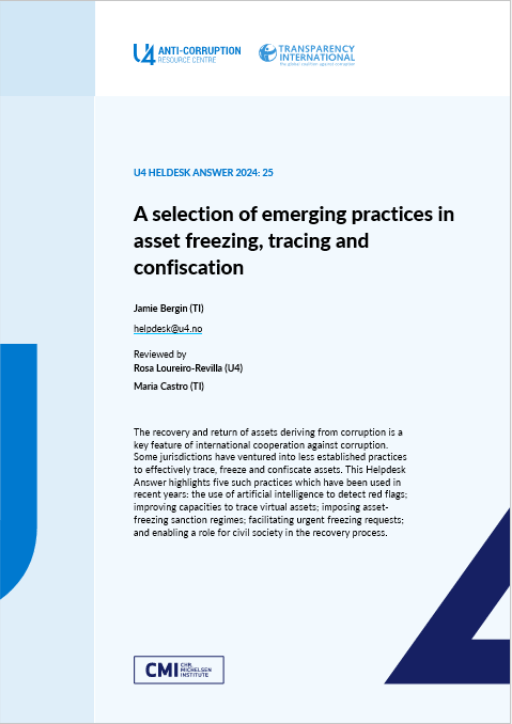- Home
- Anti-Corruption Helpdesk
- A selection of emerging practices in asset freezing, tracing and confiscation
A selection of emerging practices in asset freezing, tracing and confiscation

This Anti-Corruption Helpdesk brief was produced in response to a query from a U4 Partner Agency. The U4 Helpdesk is operated by Transparency International in collaboration with the U4 Anti-Corruption Resource Centre based at the Chr. Michelsen Institute.
Query
Please provide a summary of five emerging asset recovery practices.
Summary
The recovery and return of assets deriving from corruption is a key feature of international cooperation against corruption. Some jurisdictions have ventured into less established practices to effectively trace, freeze and confiscate assets. This Helpdesk Answer highlights five such practices which have been used in recent years: the use of artificial intelligence to detect red flags; improving capacities to trace virtual assets; imposing asset-freezing sanction regimes; facilitating urgent freezing requests; and enabling a role for civil society in the recovery process.
Main points
- With the adoption of the United Nations Convention against Corruption (UNCAC) in 2003, asset recovery became a key feature of international cooperation against corruption. However, experts have highlighted different barriers to recovery and changes to the technological landscape, resulting in a need to consider additional efforts to complement and strengthen asset recovery processes.
- Some jurisdictions have started using artificial intelligence and machine learning to overcome resource challenges and support the mining of large volumes of data, including suspicious activity reports and asset declarations. These tools can proactively identify red flags and provide law enforcement with potential leads and actionable intelligence for asset tracing.
- Virtual assets provide a possible avenue to launder the proceeds of corruption due to their relative anonymity. Hence, greater investment into in-house capacities and the use of third-party specialists can help competent authorities to effectively trace these assets.
- Asset-freezing sanction regimes are largely spearheaded by executive rather than judicial authorities and can be effective in swiftly freezing assets. However, such sanctions may provide a limited basis for further confiscation and recovery.
- Urgent freezing measures prevent suspects from relocating their assets at short notice and are more likely to be implemented where informal communications and trust between requesting and requested national authorities are fostered.
- Civil society organisations can play a vital role in gathering intelligence and driving legal processes towards asset confiscation, although they require an enabling environment to operate.
- While a sense of stagnation in the rate of assets seized globally has contributed to calls for acceleration, this must be balanced with upholding fundamental procedural safeguards and the rule of law. Some practices carry vulnerabilities to abuse and pose evidentiary challenges which can jeopardise the long-term confiscation and return of assets.
- There is no one-size-fits-all approach to recovering assets, and the deployment of less established practices should be informed by the specific context of each case, including barriers present and the jurisdictions affected.
- The five practices highlighted were not systematically selected and thus should not be considered exhaustive or representative of all developments in the wider field.
Contents
Introduction
Five emerging practices in asset freezing, tracing and confiscation
- Using artificial intelligence (AI) and machine learning (ML) to support the tracing of assets
- Enhancing capacities relating to virtual assets
- Asset-freezing sanction regimes
- Urgent freezing measures
- Enhancing the role of civil society organisations
References
Authors
Jamie Bergin (TI) [email protected]
Reviewed by
Rosa Loureiro-Revilla (U4)
Maria Castro (TI)
Date
07/06/2024

